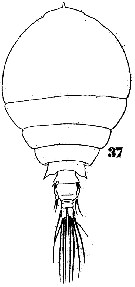|
|
 |
|
Cyclopoida ( Order ) |
|
|
|
incertae sedis (Cyclopoida) ( Family ) |
|
|
|
Pachos ( Genus ) |
|
|
| |
Pachos tuberosum (Giesbrecht, 1891) (F,M) | |
| | | | | | | Syn.: | Pachysoma tuberosum Giesbrecht, 1891; 1892 (p.612, 615, 774, Descr.F, fig.F); Cleve, 1904 a (p.183, 194); Farran, 1936 a (p.129); Sewell, 1947 (p.272);
Pachysoma dentatum : Mori, 1932 a (p.172, figs.M); 1937 (1964) (p.142, figs.M, no F) | | | | Ref.: | | | Boxshall, 1977 a (p.153, Descr.M, figs.M); Bradford-Grieve & al., 1999 (p.887, 970, fig.F); Boxshall & Halsey, 2004 (p.620) |  issued from : G.A. Boxshall in Bull. Br. Mus. nat. Hist. (Zool.), 1977, 31 (3). [p.152, Fig.25, e-k]. Male (from 18°N, 25°W): e, habitus (dorsal); f, urosome (ventral); g, A2 (anterior); h, Mxp (anterior); i, Md (anterior); j, Mx1 (posterior); k, Mx2 (ventral).
|
 issued from : T. Mori in The pelagic Copepoda from the neighbouring waters of Japan, 1937 (1964). [Pl.80, Figs.6-8, 12-13]. As Pachysoma dentatum. Male (23°8'42''N, 123°51'52''E): 6, Mxp; 7, A1; 8, A2; 12, P4; 13, habitus (dorsal). Nota: - Terminal segment of A2 with 1 stout and 4 slender setae (instead of 5 slender setae of P. punctatum). - Proximal portion of the inner margin of the 2nd segment of basipodite of Mxp denticulate and with 1 spine; the 2nd segment of endopodite terminates into the simple claw. The hook-like spine on the proximal portion of this segment is about 5/12 times as long as the segment itself.
|
 Issued from : W. Giesbrecht in Systematik und Faunistik der Pelagischen Copepoden des Golfes von Neapel und der angrenzenden Meeres-Abschnitte. – Fauna Flora Golf. Neapel, 1892. Atlas von 54 Tafeln. [Taf.48, Fig.37]. As Pachysoma tuberosum. Female: 37, habitus (dorsal).
| | | | | Compl. Ref.: | | | Wilson, 1942 a (p.200); De Decker, 1964 (p.16, 23, 27); Boxshall, 1977 b (p.552); Neumann-Leitao & al., 2008 (p.799: Tab.II, fig.6) | | | | NZ: | 7 | | |
|
Distribution map of Pachos tuberosum by geographical zones
|
| | | | | | | | | | Loc: | | | South Africa (E), off Cape Verde Is., off SE Sri Lanka, Indian, Nicobar Is. (Nankauri Harbour), Taiwan, off S Japan, Australia (Great Barrier), G. of Panama, N Brazil. | | | | N: | 8 | | | | Lg.: | | | (34) F: 1,95; (46) F: 2; (91) M: about 2,1; (139) M: 2; (151) M: 2,14; (786) M: 2,63-2,58; {F: 1,95-2,00; M: 2,00-2,63} | | | | Rem.: | epipelagic.
According to Boxshall (1977 a, p.153) there are no significant differences between the male of P. dentatum described by Mori (1932, 1937) and the male of P. tuberosum. Mori found only 1 stout and 4 slender setae around the apex of A2 of male P. dentatum but the absence of a small seta from the subapical group (in fig.25g) does not justify specific recognition especially when the seta is easily overlooked.
Morphological characteristic after Bradford-Grieve & al. (1999):
Female & Male: - P1-P4 with inner coxal seta. P5 fused with urosomite 1, with 2 setae and 2 basal setae. | | | Last update : 07/12/2020 | |
|
|
 Any use of this site for a publication will be mentioned with the following reference : Any use of this site for a publication will be mentioned with the following reference :
Razouls C., Desreumaux N., Kouwenberg J. and de Bovée F., 2005-2025. - Biodiversity of Marine Planktonic Copepods (morphology, geographical distribution and biological data). Sorbonne University, CNRS. Available at http://copepodes.obs-banyuls.fr/en [Accessed December 31, 2025] © copyright 2005-2025 Sorbonne University, CNRS
|
|
 |
 |






